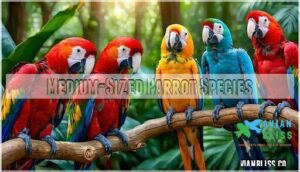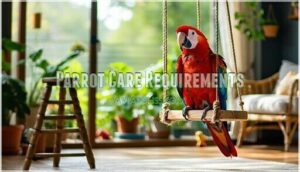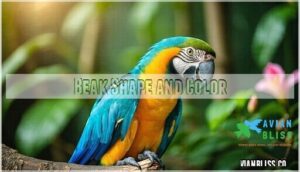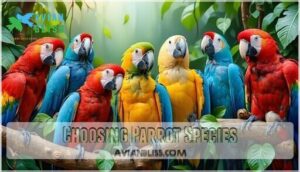This site is supported by our readers. We may earn a commission, at no cost to you, if you purchase through links.
 When you look at the types of parrots, you’ll spot everything from pint-sized budgies that chirp like tiny car alarms to massive macaws, vivid as a festival.
When you look at the types of parrots, you’ll spot everything from pint-sized budgies that chirp like tiny car alarms to massive macaws, vivid as a festival.
Parrots fall into categories based on their size, beak shape, and striking color—think green Amazon parrots, clever African greys, shaggy cockatoos, and fiery conures.
They share a unique trait: zygodactyl feet, two toes forward and two back, perfect for climbing and mischief-making. Each kind’s got its own social style, diet, and quirks.
Like finding your flock, choosing among the types of parrots is about matching personalities—your next feathered friend might surprise you!
Table Of Contents
- Key Takeaways
- Parrot Classification
- Parrot Species Overview
- Popular Pet Parrots
- Parrot Care Requirements
- Identifying Parrot Species
- Choosing Parrot Species
- Frequently Asked Questions (FAQs)
- What’s the most common type of parrot?
- What is the friendliest parrot breed?
- What kind of parrot can talk?
- What is the cutest parrot species?
- What are the different types of parrots?
- What do parrots have in common?
- How many species of parrots are there?
- What are the most common pet parrots?
- What is the best type of parrot as a pet?
- What kind of parrots can talk?
- Conclusion
Key Takeaways
- You’ll spot over 400 parrot species, each with standout colors, beak shapes, and personalities.
- Parrots share zygodactyl feet, curved beaks, and sharp intelligence—traits that make them master climbers and social companions.
- Picking the right parrot means matching its size, care needs, and temperament with your own lifestyle and experience.
- Popular pet parrots like budgies, African Greys, and cockatoos each bring unique social habits and daily care requirements.
Parrot Classification
You’ll find that parrots fit into distinct scientific groups based on beak shapes, foot types, and family trees, making them a fascinating bunch to sort out.
Don’t worry if you can’t tell a cockatoo from a conure at first—nature’s variety can stump even the best birdwatchers!
Characteristics of Parrots
Curiosity defines every parrot you’ll meet. These birds flaunt vibrant feather coloration, unmatched parrot intelligence, and sharp vocal mimicry.
Every parrot is a burst of color and cleverness, always eager to surprise you with their antics and charm.
With countless parrot species, parrot types, breeds, and varieties, you’ll notice:
- Lively social behavior
- Lifespans often outlast goldfish—some reach 60 years!
- Reliable problem-solvers
- Complex family bonds
- Breed characteristics tailor-made for survival (and mischief)
Parrots always keep you guessing, with their vibrant feather coloration and ability to form complex family bonds.
Types of Beaks and Feet
In the context of parrot species, two things stand out—curved beaks and zygodactyl feet.
Parrot anatomy is an engineer’s dream, built for Beak Strength and Foot Dexterity.
These climbing adaptations evolved for grasping abilities, letting parrots crack nuts and dangle upside down.
Every parrot type owes its survival to these evolutionary marvels, mixing fashion and function!
These beaks, primarily composed of keratin covering bone, are continuously growing and wearing down.
Importance of Zygodactyl Feet
Now that you know about beaks, let’s talk feet—specifically, zygodactyl feet.
This parrot anatomy trait means two toes face forward and two back, boosting Foot Strength and Perching Stability.
You’ll notice parrot species using these feet for Climbing Adaptations, Object Manipulation, and even hanging upside down. It’s a real game-changer among parrot varieties and parrot types!
Parrot Species Overview
You’ll find over 400 parrot species worldwide, ranging from tiny budgies to massive macaws, each classified into four main families based on their traits and origins.
Understanding these groups helps you spot differences in size, color, and behavior, so you won’t mistake a cockatoo for a lovebird at your next birdwatching adventure.
Small Parrot Species
After exploring what makes parrots unique, let’s look at small parrot species.
Pygmy parrots, Parrotlets, and Budgies are popular choices, often called “finch-sized parrots.”
Parakeet types like Budgies stand out for their bright colors and social skills.
Small conures and Parrotlets bring big personalities in tiny packages, making Budgie care and small parrots appealing for many homes.
Medium-Sized Parrot Species
Between the tiny budgie and the mighty macaw, medium-sized parrots—like the conure parrot, amazon parrot, senegal parrot, pionus parrot, and quaker parrot—offer a vibrant mix of traits.
You’ll notice:
- Plumage variations from subtle to bold
- Wide-ranging vocalizations and temperament
- Unique habitat needs in the wild
- Captive breeding supporting pet populations
These birds balance personality and manageability, making them a great choice for those who want a vibrant mix of traits.
Large Parrot Species
While medium parrots bring color and chatter, large parrot species like the macaw parrot and amazon parrot steal the spotlight with size and smarts.
Macaw intelligence is legendary, and the Hyacinth lifespan can reach 80 years.
Goliath behavior keeps you guessing, while Ara diet needs variety—think nuts and fruit.
Congo adaptation shows how these birds thrive in changing habitats.
Some of the largest parrots, like the Blue-and-Gold Macaw, are known for their social and loud nature.
Very Large Parrot Species
Grandeur defines very large parrot species, with some stretching up to 40 inches.
These giants, like the Hyacinth Macaw and Goliath Cockatoo, showcase remarkable Macaw Behavior and social bonds.
They also possess high intelligence, similar to a young child.
If you’re fascinated by parrot size or Conservation Status, consider:
- Hyacinth Macaw: longest macaw parrot
- Goliath Cockatoo: largest cockatoo parrot
- Complex Large Parrot Care needs
- Many large species are threatened
Popular Pet Parrots
When you look for a pet parrot, you’ll find species like African Greys, Budgerigars, Cockatoos, Conures, and Macaws, each with unique traits and care needs.
It’s helpful to know their scientific backgrounds and behaviors, so you don’t end up with a bird that outsmarts you at every turn, and understand their unique traits to provide proper care.
African Grey Parrots
If you’re drawn to talking parrots, the African Grey Parrot stands out for its remarkable vocalization skills and cognitive abilities.
Few birds rival the African Grey’s talent for mimicking voices and showing off their sharp, playful minds.
This parrot species can mimic hundreds of sounds and words, rivaling a toddler’s smarts. However, their intelligence brings ethical concerns and temperament issues, especially if bored.
Conservation status is endangered, so always seek ethically sourced African Greys for companionship. These birds are prone to calcium deficiency issues, requiring a carefully balanced diet to prevent health issues.
Budgies/Budgerigars
Budgies, also called parakeets, are the most common pet parrot worldwide.
These small parrots come in a rainbow of Budgie Colors and countless Budgie Mutations.
Budgie Sounds range from cheerful chirps to soft whistles, making them lively companions.
With gentle Budgie Training and fun Budgie Toys, they’re among the easiest parrots to keep—perfect for beginners.
Cockatoos
Cockatoos, crestfeathered wonders native to Australia and nearby islands, stand out among parrot species for their expressive Cockatoo Crests and bold personalities.
Their Cockatoo Sounds can fill a room, and their social Cockatoo Behavior means they crave attention.
In the wild, Cockatoo Habitats range from forests to farmlands, but Cockatoo Conservation is essential as some species face habitat loss.
Conure Parrots
If cockatoos wow you with crests, conure parrots keep things lively with their playful energy.
You’ll notice Conure Temperament is a mix of curiosity and cheekiness, while Conure Mutations offer a rainbow of colors, especially in sun conures.
These parrot types need Conure Enrichment and Conure Training, as their Conure Noises can be quite the conversation starter!
Macaws
If you think conures are lively, wait until you meet macaws.
These giants of the parrot world wow with vibrant feathers, booming macaw sounds, and unmatched Macaw Intelligence.
From the smallest Hahn’s to the massive hyacinth, macaws thrive in diverse Macaw Habitats.
As you explore parrot breed characteristics, remember, Macaw Conservation and understanding Macaw Hybrids matter for every parrot lover.
Parrot Care Requirements
When you care for a parrot, you’ll need to meet its specific needs for diet, social time, exercise, and health checks, since these birds are as demanding as they’re colorful.
It’s a bit like running a tiny zoo in your living room, but with more feathers and a lot of squawking.
Diet and Nutrition
After picking your favorite parrot species, understanding bird nutrition keeps them healthy. A well-rounded parrot diet covers seed variety, fresh veggies, and calcium sources.
Watch for nutritional deficiencies and avoid toxic foods like avocado. Formulated diets offer a balanced nutritional profile.
Foraging enrichment—scattering food or using puzzle feeders—keeps their minds sharp. Keep these in mind, and your bird’s specialized diet will support a long, colorful life.
- Seed variety and pellets
- Fresh fruits and veggies
- Calcium sources (cuttlebone, leafy greens)
- Avoid toxic foods (avocado, chocolate)
Socialization and Interaction
After a balanced diet, your parrot’s happiness depends on strong social bonds.
Parrot Bonding happens through daily Human Interaction, mimicking Flock Behavior in the wild.
Parrot socialization isn’t just for show—social enrichment and Playtime Activities prevent boredom and negative habits.
Chat, whistle, or share a snack; these moments support parrot social needs and keep their minds sharp with parrot mental stimulation.
Exercise and Environment
When you set up your parrot’s space, Cage Size matters—a cramped cage is like living in a closet.
Offer parrot toys and Enrichment Activities to encourage Natural Behaviors and parrot exercise.
Outdoor Aviaries can add variety, but watch for Environmental Hazards.
Consider appropriate cage dimensions for your parrot’s health.
Daily parrot interaction and parrot socialization boost parrot mental stimulation, keeping your feathered friend curious and content.
Health and Veterinary Care
Every parrot deserves a long, healthy parrot lifespan, so don’t wing it regarding parrot health.
Schedule yearly checkups with avian vets, watch for common ailments like feather plucking, and keep a parrot first-aid kit handy.
Having access to a complete parrot kit can be vital in emergencies.
Preventative care, clean cages, and balanced parrot nutrition help dodge nutritional deficiencies and keep your feathered friend chirping for years.
Identifying Parrot Species
You can spot different parrot species by looking at their colors, size, beak shape, and even how they act around others.
It’s a bit like being a detective, except your suspects have feathers and sometimes a loud squawk.
Visual Characteristics
Once you’ve set up your parrot’s care, spotting visual clues helps with parrot identification. Look for Plumage Coloration, Feather Patterns, and Beak Morphology—each species has its own flair.
Eye Pinning can signal excitement or curiosity. Parrot size and parrot weight also vary widely.
Here’s what to watch for:
- Plumage Coloration
- Feather Patterns
- Beak Morphology
- Eye Pinning
- Size Variation
Behavioral Traits
Someone curious about parrots will notice that parrot behavior and temperament can range from playful mischief to impressive problem solving.
Social Behavior is key—these birds crave interaction, showing off their parrot personality through Vocal Mimicry and clever games.
Destructive Behaviors often signal boredom, while strong Learning Capacity reveals just how much their emotional wellbeing depends on daily engagement and variety.
Some parrot species also exhibit complex communication signals, similar to other bird species, demonstrating their complex communication abilities.
Size and Weight
After spotting a parrot’s quirky behaviors, you’ll notice that parrot species size and parrot species weight tell their own story.
From tiny budgies weighing an ounce to hefty macaws tipping the scales, size and lifespan often go hand in hand.
Weight vs. flight matters—lighter birds soar easily.
Watch for parrot dimorphism and practice smart weight management for healthy companions.
Beak Shape and Color
When you look at different parrot species, notice their curved beak—nature’s Swiss Army knife.
Beak Functionality varies: cracking seeds, climbing, or peeling fruit.
Beak Evolution led to all sorts of Specialized Beaks, with parrot colors sometimes hinting at age or health.
Watch for Beak Abnormalities, as these can signal problems.
Color Significance? Sometimes, it’s just a flashy bird beak, related to Beak Functionality.
Choosing Parrot Species
When you’re choosing a parrot species, you’ll need to think about factors like size, lifespan, and daily care needs, since parrots range from tiny budgerigars to large macaws.
It’s a bit like picking a roommate who squawks, chews, and expects you to know your Psittacidae from your Cacatuidae.
Considerations for Beginners
When starting out with parrots, you’ll want to choose beginner species like budgies or cockatiels, known as the most common pet parrot and often the easiest parrot for new owners.
Consider initial costs, housing needs, and relatively low noise levels. Smaller parrot species fit well in apartments, but remember, even the best parrot needs daily time commitment and social interaction.
To properly house a budgie, consider purchasing a complete habitat setup to ensure you provide a suitable environment for your pet.
Considerations for Experienced Owners
With experience under your belt, you’ll find parrot care requires a sharper focus on Advanced Training and enrichment strategies.
Keep in mind:
- Tackling Breeding Challenges with rare parrot species
- Managing complex diets for healthy parrot health
- Addressing behavioral issues from high parrot intelligence
- Budgeting for higher parrot price and specialized care
Your expertise lets you enjoy a richer, more rewarding relationship, built on enrichment strategies.
Matching Parrot Species to Lifestyle
Choosing the right parrot species means matching their quirks to your daily rhythm.
Some parrots thrive in busy homes, while others prefer peace and quiet.
Think about Space Requirements, Noise Levels, and Time Commitment.
Here’s a handy table to help you balance parrot temperament and parrot suitability with your lifestyle:
| Factor | Consideration |
|---|---|
| Space Requirements | Large vs. Small |
| Noise Levels | Quiet vs. Loud |
| Time Commitment | High vs. Low |
| Family Compatibility | Kids, Pets |
| Budget Considerations | Food, Vet, Toys |
Frequently Asked Questions (FAQs)
What’s the most common type of parrot?
Like a feather in the cap of the parrot world, budgerigars, or budgies, take the prize as the most common type.
You’ll spot these small, chirpy, colorful birds everywhere, especially in homes worldwide.
What is the friendliest parrot breed?
If you want a social, gentle companion, budgerigars—budgies for short—often lead the pack.
These small, chatty birds love mingling, easily bond with people, and bring cheer to any flock, no bird-brained drama included.
What kind of parrot can talk?
Imagine you’ve got a feathered stand-up comic—African Greys, Amazon parrots, and Budgerigars steal the show for talking skills.
You’ll hear full sentences, jokes, and even mimic your favorite song if given patient practice and care.
What is the cutest parrot species?
The budgerigar, or “budgie,” claims the title for cutest parrot species with its tiny size, vibrant colors, and playful antics.
You’ll find its chirpy personality and expressive face hard to resist—they’re basically feathered comedians.
What are the different types of parrots?
Picture parrots perched proudly, popping with color and character.
You’ll find four main families: Psittaculidae, Psittacidae, Cacatuidae, and Strigopidae.
Each sports unique beaks, crests, and quirks, making birdwatching a real feathered fiesta!
What do parrots have in common?
You’ll spot a parrot by its curved beak, zygodactyl feet—two toes forward, two back—and a sharp mind.
They’re all social birds, crave company, sport bright plumage, and love a good problem to solve.
How many species of parrots are there?
Just like a wildly colored patchwork quilt, the parrot family boasts over 400 unique species, each with its own charm.
From the tiny pygmy parrots to giant macaws, you’ll find vibrant diversity throughout this bird order.
What are the most common pet parrots?
You’ll often find African Greys schooling you in vocabulary, Amazons belting out tunes, cockatiels whistling their hearts out, and lovebirds snuggling with attitude—these are just a few species that make popular, personable pet parrots.
What is the best type of parrot as a pet?
You might find budgerigars, cockatiels, and African Grey Parrots make great companions, each with quirks like playful chatter or clever mimicry.
Just remember, these birds thrive with attention, mental stimulation, and a flock—yep, that’s you, and they require attention to be happy and healthy.
What kind of parrots can talk?
Ask an African Grey, chat with an Amazon, or laugh with a Budgie—each can mimic human speech, but African Greys top the charts.
Offer mental puzzles, consistent words, and daily chatter to encourage their verbal skills.
Conclusion
Like a scientist sorting colorful gems, you’ll notice the diversity within the types of parrots is vast and fascinating.
When picking your companion, pay attention to traits such as size, beak shape, and behavior.
Matching your lifestyle with a parrot’s needs helps guarantee both you and your feathered friend thrive.
Take time to research species, observe their quirks, and don’t rush—finding the right parrot can be as rewarding as the most well-planned scientific expedition to ensure you find a perfect companion that fits your lifestyle and needs, making it a truly rewarding experience.
- https://en.wikipedia.org/wiki/Parrot
- https://friendoftheearth.org/save-the-parrots/
- https://www.audubon.org/news/parrots-among-most-threatened-bird-groups
- https://www.ahsvet.com/site/blog/2022/07/15/parrot-types
- https://parrotessentials.co.uk/blog/12-popular-parrot-breeds-and-how-to-choose-the-right-one














